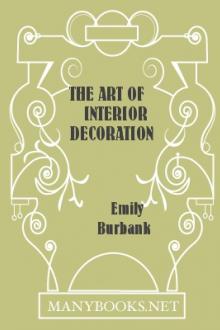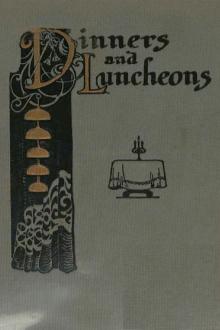The Art of Interior Decoration, Emily Burbank [big ebook reader txt] 📗

- Author: Emily Burbank
- Performer: -
Book online «The Art of Interior Decoration, Emily Burbank [big ebook reader txt] 📗». Author Emily Burbank
William Morris was an epoch maker in English interior decoration, for he stood out for the "great, simple note" in furnishings. The pre-Raphaelites worked successfully to the same end, reviving classic simplicity and establishing the value of elimination. The good, modern furniture of to-day, designed with reference to meeting the demands of modern conditions, undoubtedly received a great impetus from that reaction to the simple and harmonious.
CHAPTER XXII THE COLONIAL PERIODThe furniture made in America during the eighteenth and early nineteenth centuries was reproduced from English models and shows the influence of Chippendale, Sheraton, Heppelwhite and the Adam brothers. For those interested in these early types of American output, the Sage and other collections in the Metropolitan Museum, New York, give a delightful object lesson, and there has been much written on the subject in case any data is desired.
If some of our readers own heirlooms and plan reproducing Colonial interiors of the finest type, we would advise making an effort to see some of the beautiful New England or Virginia homes, which remain quite as they were in the old days; fine square rooms with hand-carved woodwork, painted white, their walls panelled in wood and painted the same white. Into these panels were set hand-painted wall paper. The authors saw some made for a house in Peabody, near Salem, Massachusetts, some time between 1760 and 1800, and were amazed to find that the colours were as vivid as when first put on.
Here let us say that the study of interior decoration throws a strong light on the history of walls. In Gothic days the stone or wood of the feudal hall was partially concealed by tapestries,—the needlework of the women of the household, a record of the gallant deeds of men used as interior decoration. Later of course, the making of tapestries became a great industry in Italy, France and Belgium, an industry patronised by kings and the nobility, and subsidised by governments.
Next we have walls sheathed with wood panelling. Then during the late Renaissance, painted portraits were let into these panels and became a part of the walls. Later, the upper half, or two-thirds of the panelling, was left off, and only a low panelling, or "dado," remained. This, too, disappeared in time.
Landscape paper was the bridge between the panelled walls with pictures built into them, and the painted or papered walls with pictures hung on them. The paper which we have already referred to, is one of the finest examples of its kind, and while there is only enough for one side of a room, it is valued at $5,000. The design is eight feet high, each strip 22 inches wide, and there are eighteen of the original twenty strips. Two breaks occur, numbers 16 and 18. The owner believes that the Puritan attitude of her ancestors caused them to destroy the panels which showed nude figures engaged in battle. This paper is now the property of Mrs. Eliza Brown of Salem, Massachusetts. It was found in her grandfather's attic in Gloucester, and was given to Mrs. Brown by her grandmother. It was in an army chest belonging to Judutham Baldwin, a Colonel of Engineers in the Revolutionary Army, who laid out the forts in Boston Harbour.
Kate Sanborn, in her book on "Old Wall Papers" speaks of this particular paper. "Paper from the Ham House at Peabody, Massachusetts, now occupied by Dr. Worcester. Shows tropical scenes. These scenes are quite similar to those of the Pizarro paper and may have been the work of the same designer." (The so-called "Pizarro in Peru" paper is shown in plate 34 and 35 of the same book, and is in Duxbury, Mass.) Pizarro's invasion of Peru was in 1531. The colouring of Mrs. Brown's paper is white background with foliage in vivid greens, while figures of Peruvians wear costumes of brilliant blues and vermillion reds, a striking contrast to their soft, brown skins.
This paper is now in the market, but let us hope it may finally rest in a museum.
CHAPTER XXIII THE REVIVAL OF DIRECTOIRE AND EMPIRE FURNITUREThe revival of Directoire and Empire furniture within the past few years, is attributed by some, to that highly artistic, and altogether illuminating publication, the Gazette do Bon Ton—Arts, Modes and Frivolities—published in Paris by the Librarie Centrale des Beaux Arts, 13 rue Lafayette and contributed to by the leading artists of Paris—the ultra moderns.
There was a time, fifteen or twenty years ago, when one could buy Empire furniture at very low figures, for in those days there was many a chance to pick up such pieces. To-day, a genuine antique or a hand-made reproduction of an antique made sixty years ago, will command a large price, and even in Paris one has difficulty in finding them in the shops at any price.
Empire furniture ceased to be admired in America when the public got "fed up" on this type by its indiscriminate use in hotels and other public buildings.
The best designers of modern painted furniture are partly responsible for the revived interest in both Empire and Directoire. From their reproductions of the beautiful simple outlines, we, as a people, are once more beginning to feel line and to recognise it as an intrinsic part of beauty.
A Victorian group in a small portion of a very large parlour, 70 x 40 feet, one of the few remaining, if not the last, of the old Victorian mansions in New York City, very interesting as a specimen of the most elegant style of furnishing in the first half of the nineteenth century.
We would call attention to the heavy moulding of ceilings, the walls painted in panels (painted panels or wall paper to represent panels, is a Victorian hallmark), beautifully hand-carved woodwork, elaboration of design and colon carpet, woven in one piece for the room; in fact the characteristic richness of elaboration everywhere: Pictures in gilded carved frames, hung on double silk cords with tassels, heavily carved furniture made in England, showing fruits, flowers and medallion heads, and a similar elaboration and combination of flora and figures on bronze gas fixtures.
Heavy curtains of satin damask hung at the windows, held back by great cords and tassels, from enormous brass cornices in the form of gigantic flowers.
Also of the period is an immense glass case of stuffed birds, standing in the corner of the large dining-room. This interior was at the height of its glory at the time of the Civil War, and one is told of wonderful parties when the uniforms of the Northern officers decorated the stately rooms and large shaded gardens adjoining the house.
As things go in New York it may be but a matter of months before this picturesque landmark is swept away by relentless Progress.

Gradually architecture and interior decoration drew apart, becoming two distinct professions, until during the Victorian era the two were unrelated with the result that the period of Victorian furniture is one of the worst on record.
There were two reasons for this divorce of the arts, which for centuries had been one in origin and spirit; first, the application of steam to machinery (1815) leading to machine-made furniture, and second, the invention of wall-paper which gradually took the place of wood panelling and shut off the architects from all jurisdiction over the decoration of the home.
With the advent of machine-made furniture came cheap imitations of antiques and the rapid decadence of this art. Hand-made reproductions are quite another thing. Sir Richard Wallace (of the Wallace Collection, London) is said to have given $40,000 for a reproduction of the bureau du Louvre.
Fortunately, of late years a tide has set in which favours simple, well made furniture, designed with fine lines and having special reference to the purposes for which each piece is intended, and to-day our houses can be beautiful even if only very simple and inexpensive furniture is used.
In the Victorian prime, even the carved furniture, so much of which was made in England both for that country and the United States (see Plate XXI), was not of the finest workmanship, compared with carvings of the same time in Belgium, France, Germany and Austria.
To-day Victorian cross-stitch and bead work in chairs, screens, footstools and bell-pulls, artificial flowers of wax and linen, and stuffed birds, as well as Bristol glass in blue, green and violet, are brought out from their hiding places and serve as touches of colour to give some of the notes of variety which good interior decoration demands.
To be fascinating, a person must not be too rigidly one type. There must be moments of relaxation, of light and shade in mood, or one is not charmed even by great beauty. So your perfect room must not be kept too rigidly in one style. To have attraction it must have variety in both line and colour, and reflect the taste of generations of home lovers. The contents of dusty garrets may add piquancy to modern decorations, giving a touch of the unusual which is very charming.
CHAPTER XXV PAINTED FURNITUREPainted furniture is, at present, the vogue, so if you own a piece made by the Adam brothers of England, decorated by the hand of Angelica Kauffman, or Pergolesi, from Greek designs, now is the moment to "star" it.
Different in decoration, but equal in charm, is the seventeenth and eighteenth century painted lacquers of Italy, France, China and Japan. In those days great masters laboured at cabinetmaking and decorating, while distinguished artists carved the woodwork of rooms, and painted the ceilings and walls of even private dwellings.
To-day we have reproductions (good and bad) of the veteran types, and some commendable inventions, more or less classic in line, and original in colouring and style of decoration. At times, one wishes there was less evident effort to be original. We long for the repose of classic colour schemes and classic line. In art, the line and the combination of colours which have continued most popular throughout the ages, are very apt to be those with which one can live longest and not tire. For this reason, a frank copy of an antique piece of painted furniture is generally more satisfactory than a modern original.
If you are using dull coloured carpets and hangings, have your modern reproductions antiqued. If you prefer gay, cheering tones, let the painted furniture be bright. These schemes are equally interesting in different ways. It is stupid to decry new things, since every grey antique had its frivolous, vivid youth.
One American decorator has succeeded in making the stolid, uncompromising squareness of mission furniture take on a certain lightness and charm by painting it black and discreetly lining it with yellow and red. Yellow velour is used for the seat pads and heavy hangings, thin yellow silk curtains are hung at the windows, and the black woodwork is set off by Japanese gold paper. In a large house, or in a summer home where there are young people coming and going, a room decorated in this fashion is both gay and charming and makes a pleasant contrast to darker rooms. Then, too, yellow is a lovely setting for all flowers, the effect being to intensify their beauty, as when flooded by sunshine.
Another clever treatment of the mission type, which we include under the heading Painted Furniture, is to have it stained a rich dark brown, instead of the usual dark green. Give your dealer time to order your furniture unfinished from the factory, and have stained to your own liking; or, should you by any chance be planning to use





Comments (0)